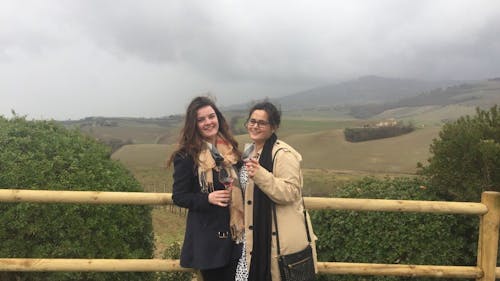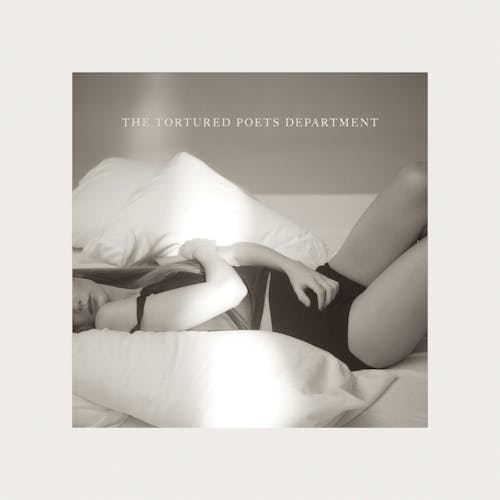Recipes from Rome: Wining in Tuscany

Last weekend, on a cold and drizzly March morning, my roommate and I took a day trip with a tour group to the towns of Montepulciano and Montalcino in Tuscany for a wine tasting. We foolishly went out the night before, thinking we would sleep on the 3-hour bus ride to Montepulciano, but the stunning views of the countryside made it impossible to sleep. We stumbled out of the bus onto the asphalt of the bus depot, blinking at the light and shivering a bit from the cold mist. It was already beautiful.
Without warning, we began a hike through the town that can only be described as arduous. Tuscan hill-top towns are strikingly beautiful, but it should not be forgotten that they are very hilly. And when you’re hungover and working on about 2 hours of sleep, you may have to step to the side and discretely dry heave while your roommate rubs your back. I’m not speaking from personal experience, of course.
Once we made it to what felt like the absolute top of the town, there was a beautiful overlook from which you could look out over the countryside around the town. The day was gray, but far from dreary. The colors, mist and eerie emptiness amplified the Medieval atmosphere of the town, making us feel like we had traveled back in time.
Our next stop was at a cantina owned by the Gattavecchi family, who are winemakers in the town of Montepulciano. We toured their cellar, even going down all the way to an old Etruscan cellar. One of the members of the family, Daniela, explained to us the many ways the Sangiovese grape is used to make different wines. We then proceeded upstairs to have lunch and taste some wines.
The first wine we tasted was the Rosso di Montepulciano. The Rosso was cloudy and tannic, but very bright and acidic. We drank it with a platter of typical Tuscan meats and cheeses.
Next we had a Vino Nobile di Montepulciano, which was served alongside a classic Tuscan dish called Pici al Sugo. Pici are thick, hand rolled spaghetti-like pasta typical of the Tuscan region that were invented out of necessity by women who only had flour and water to make pasta. The homemade pici were tossed with a classic, rich bolognese sauce that had cooked for 3 hours. The Vino Nobile was older than the first wine, so it was much clearer and mellower, but more complex.
Daniela was more than a generous pourer and had to ask one of the servers to go open more bottles of wine more than once. The third wine we tasted was another Vino Nobile, but this time it was the Riserva. The Riserva must be aged for a minimum of 36 months (compared to regular Vino Nobile’s 24). This wine was delicious, very smooth with intense flavors of cherry and plum.
We were not yet done with our tasting, though. The last wine was a dessert wine, Vin Santo di Montepulciano. It was served with delicious and nutty biscotti for dipping. After saying goodbye to Daniela, we were able to explore the town of Montepulciano for a while before heading back to the bus and leaving for our second vineyard of the day.
Again, the scenery made napping on the bus impossible — also the fact that we were in a giant bus going down tiny country roads in the pouring rain. We arrived at the Altesino winery, located a bit outside of the town of Montalcino. Thankfully, just as the bus pulled up, the pouring rain stopped. We were greeted by Giulia, who took us to see where the wine was made.
First we went to a room where the wine was aged in giant steel drums. Giulia explained how long different wines are aged, and in what types of barrels. Their white wine, for instance, never leaves the steel drums, but all of their red wines are aged for varying periods of time in different types of wood barrels. Montalcino is famous for Brunello di Montalcino (and to a lesser extent Rosso di Montalcino), which have strict guidelines for how they can be produced.
After stepping outside and taking in the view a bit, we went into the tasting room to try some of the wines from the vineyard. First, the Rosso di Montalcino, then the Palazzo Altesi and finally the Brunello di Montalcino. The Rosso di Montalcino and Brunello di Montalcino had to be produced following very strict guidelines, as their names are protected by Italian law. They were, of course, both incredibly delicious. The Palazzo Altesi is very interesting because it is made entirely from Sangiovese grapes but aged in a different type of barrel. The result is a wine that is at the same time both similar to the Brunello and very different, with an almost toasty flavor.
We got back onto the bus and headed back to Rome, slightly buzzed, with bottles of wine in our purses and a newfound appreciation for how Tuscan wines are produced.



